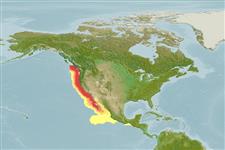Classificação / Names
Common names from other countries
Referência principal
Tamanho / Peso / Idade
Max length : 91.0 cm TL macho/indeterminado; (Ref. 1371); common length : 60.0 cm TL macho/indeterminado; (Ref. 1371); Peso máx. publicado: 1.2 kg (Ref. 4883); Idade máx. registada: 16 anos (Ref. 56527)
Length at first maturity
Lm ?, range 34 - 40 cm
Ambiente
; marinhas; estuarina; intervalo de profundidade 0 - 1000 m (Ref. 9316), usually ? - 229 m (Ref. 2850)
Clima / Intervalo
Temperate, preferred 14°C (Ref. 107945); 51°N - 15°N, 130°W - 77°W (Ref. 58452)
Distribuição
Eastern Pacific: northern Vancouver Island, Canada to northern part of the Gulf of California. A record from the Gulf of Alaska is doubtful.
Países | Áreas FAO | Ecossistemas | Ocorrências | Introduções
Descrição breve
Espinhos dorsais (total): 1; Raios dorsais moles (total): 48-56; Espinhos anais 0; Raios anais moles: 40 - 43. Head rather short. Pectoral fin tips usually reaching to or beyond the origin of anal fin. Caudal fin always concave. Color silvery on back grading to whitish ventrally.
Categoria na Lista Vermelha da IUCN (Ref. 115185)
Ameaça para o homem
Harmless
Utilização humana
Pescarias: altamente comercial
Ferramentas
Relatórios especiais
Descarregue XML
Fontes da internet
Estimates of some properties based on models
Phylogenetic diversity index
PD50 = 0.5000 many relatives (e.g. carps) 0.5 - 2.0 few relatives (e.g. lungfishes)
Nível Trófico
4.4 ±0.0 se; Based on diet studies.
Resiliência
Médio, tempo mínimo de duplicação da população 1,4 - 4,4 anos (tmax=17; tm=4; also Musick et al. 2000 (Ref. 36717))
Vulnerabilidade
High vulnerability (60 of 100)
Categoria de preço
